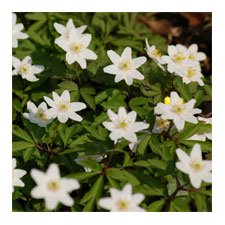Windflower | Wood Anemone
Anemone nemorosa. Crowfoot Family.
Stem. - Slender. Leaves. - Divided into delicate leaflets. Flower. - Solitary, white, pink, or purplish. Calyx. - Of from four to seven petal-like sepals. Corolla. - None. Stamens and Pistils. - Numerous.

In the wild the windflower is usually white, but may be pinkish, lilac, blue or yellow and often have a darker tint to the back of the petals. The flowers lack both fragrance and nectar.
—Within the woods,
Whose young and half transparent leaves scarce cast
A shade, gay circles of anemones
Danced on their stalks;
writes Bryant, bringing vividly before us the feathery foliage of the spring woods, and the tremulous beauty of the slender stemmed anemones. Whittier, too, tells how these
—wind flowers sway
Against the throbbing heart of May.
And in the writings of the ancients as well we could find many allusions to the same flower were we justified in believing that the blossom christened the "wind-shaken," by some poet flower lover of early Greece, was identical with our modern anemone.
Pliny tells us that the anemone of the classics was so entitled because it opened at the wind's bidding. The Greek tradition claims that it sprang from the passionate tears shed by Venus over the body of the slain Adonis. At one time it was believed that the wind which had passed over a field of anemones was poisoned and that disease followed in its wake. Perhaps because of this superstition the windflower was adopted as the emblem of sickness by the Persians. Surely our delicate blossom is far removed from any suggestion of disease or unwholesomeness, seeming instead to hold the very essence of spring and purity in its quivering cup.
 Printer-friendly version
Printer-friendly version
